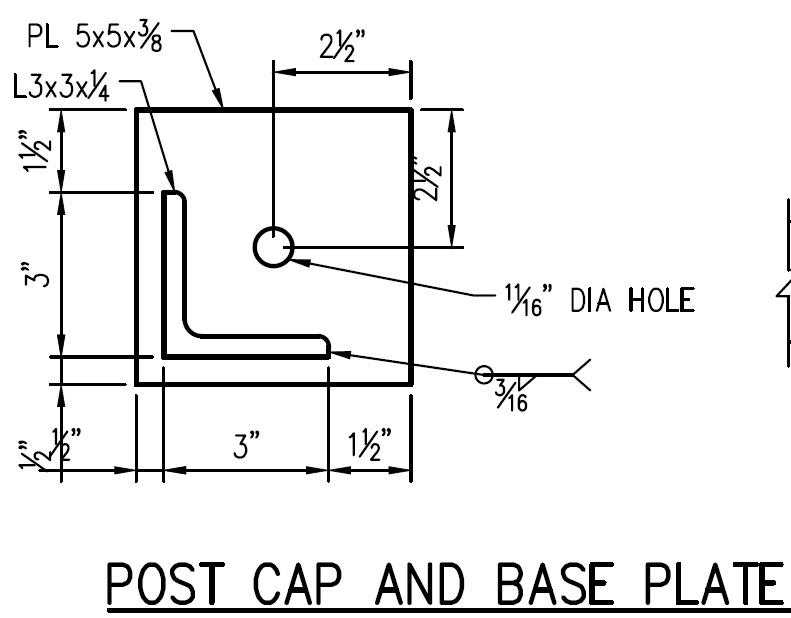Navigation
Install the app
How to install the app on iOS
Follow along with the video below to see how to install our site as a web app on your home screen.
Note: This feature may not be available in some browsers.
More options
Style variation
-
Congratulations dmapguru on being selected by the Eng-Tips community for having the most helpful posts in the forums last week. Way to Go!
You are using an out of date browser. It may not display this or other websites correctly.
You should upgrade or use an alternative browser.
You should upgrade or use an alternative browser.
Steel Angle Column Base Plate Design 2
- Thread starter AntT
- Start date
- Status
- Not open for further replies.
-
1
- #2
Design Guide one has a procedure for lightly loaded base plates where you just use a strip of steel near to the plate elements of the supported section. I'd use that same procedure applied to your angle.
I like to debate structural engineering theory -- a lot. If I challenge you on something, know that I'm doing so because I respect your opinion enough to either change it or adopt it.
I like to debate structural engineering theory -- a lot. If I challenge you on something, know that I'm doing so because I respect your opinion enough to either change it or adopt it.
- Thread starter
- #3
I've solved this (in the past) with an FEA model in about 10 minutes flat. If there is no uplift....we are talking a (even faster) hand calculation.
If you don't have the software, there are other things to try.....but I thought I'd suggest that first.
If you don't have the software, there are other things to try.....but I thought I'd suggest that first.
JoelTXCive
Civil/Environmental
Here is a detail that i came across on an old set of plans in our office.
It was used on a small work platform 36" above ground. I don't know the whereabouts of the supporting calcs.

It was used on a small work platform 36" above ground. I don't know the whereabouts of the supporting calcs.

-
1
- #6
They probably never existedJoelTXCive said:It was used on a small work platform 36" above ground. I don't know the whereabouts of the supporting calcs.
rowingengineer
Structural
For interesting connections we have been using there is a instresting learning curve but once done the program is very easy to use.
"Programming today is a race between software engineers striving to build bigger and better idiot-proof programs, and the Universe trying to produce bigger and better idiots. So far, the Universe is winning."
"Programming today is a race between software engineers striving to build bigger and better idiot-proof programs, and the Universe trying to produce bigger and better idiots. So far, the Universe is winning."
What's the loading like? If it's an angle the loads are likely tiny and I suspect the plate is fine in compression in almost pure bearing through the plate and into the concrete without much bending actually happening in the plate. If you want to assume equal bearing under the plate, fine. Find the furthest perpendicular distance between a plate edge and a leg of the angle and use that for your plate cantilever distance. Use the full plate width for resistance width. Conservative, but a quick calc and your plate is likely still going to be thin given the loads.
For tension measure from the bolt to a reasonable point on the angle (will depend on the orientation) and make an assessment based on a conservative width in bending.
For low load applications where the arrangements are awkward to do the math on, just make conservative assumptions that keep the math simple. You're not going to save money on the steel compared to the amount of work you put in.
Realistically, the angle is likely going to force a hinge in the plate at the diagonal between the two tips of the angle. You also can't fail a plate without the hinge going to the edge at some point. So bending width equal to the plate width is likely conservative for a reasonably size, reasonable thickness plate.
For tension measure from the bolt to a reasonable point on the angle (will depend on the orientation) and make an assessment based on a conservative width in bending.
For low load applications where the arrangements are awkward to do the math on, just make conservative assumptions that keep the math simple. You're not going to save money on the steel compared to the amount of work you put in.
Realistically, the angle is likely going to force a hinge in the plate at the diagonal between the two tips of the angle. You also can't fail a plate without the hinge going to the edge at some point. So bending width equal to the plate width is likely conservative for a reasonably size, reasonable thickness plate.
- Status
- Not open for further replies.
Similar threads
- Question
- Replies
- 9
- Views
- 6K
- Replies
- 7
- Views
- 5K
- Question
- Replies
- 5
- Views
- 15K
- Replies
- 11
- Views
- 11K
